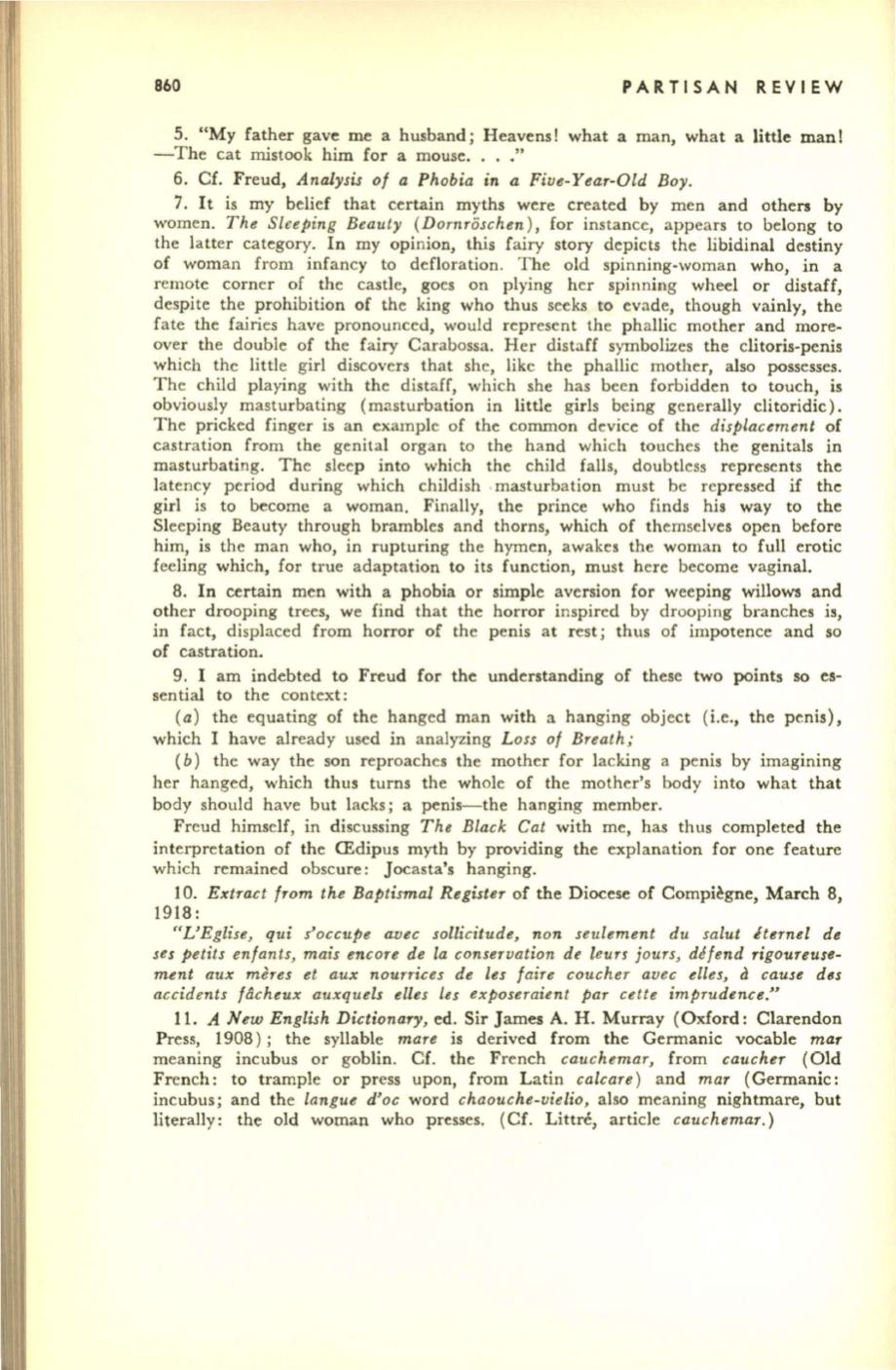
860
PARTISAN REVIEW
5. "My father gave me a husband; Heavens! what a man, what a little man!
-The cat mistook him for a mouse...."
6. Cf. Freud,
Analysis of a Phobia in a Five-Year-Old Boy.
7. It is my belief that certain myths were created by men and others by
women.
The Sleeping Beauty (Dornroschen),
for instance, appears to belong to
the latter category. In my opinion, this fairy story depicts the libidinal destiny
of woman from infancy to defloration. The old spinning-woman who, in a
remote corner of the castle, goes on plying her spinning wheel or distaff,
despite the prohibition of the king who thus seeks to evade, though vainly, the
fate the fairies have pronounced, would represent the phallic mother and more–
over the double of the fairy Carabossa. Her distaff symbolizes the clitoris-penis
which the little girl discovers that she, like the phallic mother, also possesses.
The child playing with the distaff, which she has been forbidden to touch, is
obviously masturbating (masturbation in little girls being generally clitoridic).
The pricked finger is an example of the common device of the
displacement
of
castration from the genital organ to the hand which touches the genitals in
masturbating. The sleep into which the child falls, doubtless represents the
latency period during which childish masturbation must be repressed if the
girl is to become a woman. Finally, the prince who finds his way to the
Sleeping Beauty through brambles and thorns, which of themselves open before
him, is the man who, in rupturing the hymen, awakes the woman to full erotic
feeling which, for true adaptation to its function, must here become vaginal.
8. In certain men with a phobia or simple aversion for weeping willows and
other drooping trees, we find that the horror inspired by drooping branches is,
in fact, displaced from horror of the penis at rest; thus of impotence and so
of castration.
9. I am indebted to Freud for the understanding of these two points so es–
sential to the context:
(a)
the equating of the hanged man with a hanging object (i.e., the penis),
which I have already used in analyzing
Loss of Breath;
(b)
the way the son reproaches the mother for lacking a penis by imagining
her hanged, which thus turns the whole of the mother's body into what that
body should have but lacks; a penis-the hanging member.
Freud himself, in discussing
The Black Cat
with me, has thus completed the
interpretation of the CEdipus myth by providing the explanation for one feature
which remained obscure: Jocasta's hanging.
10. Extract from the Baptismal Register
of the Diocese of Compiegne, March 8,
1918:
"L'Eglise, qui s'occupe avec sollicitude, non seulement du salut iternel de
ses petits enfants, mais encore de la conservation de leurs jours, defend rigoureuse–
ment aux meres et aux nourrices de les faire coucher avec elles,
Ii
cause des
accidents facheux auxquels elles les exposeraient par cette imprudence."
11.
A New English Dictionary,
ed. Sir James A. H. Murray (Oxford: Clarendon
Press, 1908); the syllable
mare
is derived from the Germanic vocable
mar
meaning incubus or goblin. Cf. the French
cauchemar,
from
caucher
(Old
French: to trample or press upon, from Latin
calcare)
and
mar
(Germanic:
incubus; and the
langue d'oc
word
chaouche-vielio,
also meaning nightmare, but
literally: the old woman who presses. (Cf. Littre, article
cauchemar.)


